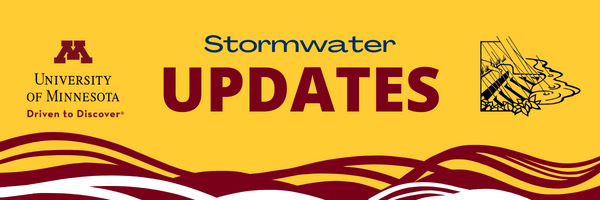
UPDATES: July 2019
Minnesota Stormwater Research Roadmap
July 2019 (volume 14 - issue 1)
Contributed by Lawrence A. Baker1, John A. Chapman1, John Bilotta2, and Shahram Missaghi3
1Department of Bioproducts and Biosystems Engineering, University of Minnesota
2Water Resources Center, University of Minnesota
3Extension, University of Minnesota
Funded by the Minnesota Clean Water Land and Legacy Amendment funds allocated through the Minnesota Pollution Control Agency.
Why stormwater research is important
Many of Minnesota’s urban waters are impaired. In the seven-county Metro region of Minnesota alone there are 369 water quality impairments, which means that these water bodies do not meet water quality standards. The major impairments are nutrients (184), mercury (140), and chloride (22). The future cost of meeting Clean Water goals using conventional approaches is likely to be very high - estimated to be $317 million per year (Barr Engineering, 2017). Finally, stormwater professionals generally perceive that current stormwater management is not as efficacious as they could be.
Research to improve stormwater management practices would likely result in improved stormwater management and accelerate progress toward Minnesota’s statewide water quality goals. There are two reasons for believing this. First, many completed stormwater research projects have resulted in the implementation of improved stormwater management practices. Examples of research that have resulted in improved stormwater management practices in include work on iron-enhanced sand filters and enhanced street sweeping.
Second, future research may become even more productive because it would be informed by our vastly improved capacity to acquire, store, and process information in recent years, enabling development of a new generation of stormwater management practices. As one example, the development of “connected impervious surface” mapping allows much more precise targeting of stormwater practices.
The Minnesota Cities Stormwater Coalition summarized these thoughts in a letter to the Minnesota Clean Water Council in 2018:
“Urban stormwater is still a relatively new field and we have huge and important gaps in our knowledge and understanding.”
Approach
One of the key ideas behind our approach was to obtain a clear view of the perceptions of stormwater managers regarding barriers and opportunities on the pathway toward clean water. We started by conducting a review of relevant stormwater-related documents; we then developed a statewide survey of stormwater managers, conducted four focus groups, and conducted a number of policy actor interviews with knowledgeable and highly experienced stormwater professionals.
The statewide survey was administered to 480 stormwater practitioners, professionals, and policy administrators across Minnesota in five types of organizations: (1) Municipal Separate Storm Sewer Systems (MS4) permittees; (2) Watershed Management Organizations; (3) Watershed Districts; (4) Soil Water Conservation Districts; and (5) County Water Planners. We received about 150 responses from across the State.
Research needs
Using information from all sources to identify problems and opportunities, we then translated problems into research questions and into eight broad research needs. These were:
- Improve characterization of urban stormwater and watersheds
- Evaluate the efficacy of stormwater management practices at the watershed scale
- Inform effective pollution reduction at the source
- Improve performance and reduce maintenance on structural BMPs
- Determine the cost efficiency of stormwater practices
- Develop new and innovative stormwater management practices
- Education to improve public perception of stormwater management and to improve effectiveness of citizens’ actions to improve water quality
- Improve stormwater management policies.
These research needs were incorporated in a Request for Proposals (RFP) developed in the Water Resources Center’s new Minnesota Stormwater Research Council. Nine new projects were recently awarded. More information about these projects can be found online at https://www.wrc.umn.edu/projects/stormwater
Next Steps
The Research Roadmap was driven by the idea that ongoing, adaptive research can improve the performance of the overall Clean Water Fund program. The current Research Roadmap was a starting point; for the concept to be successful continued assessment of needs, expanding our vision of where solutions can be found, translating the research into practice, coordination of resources and partners and keeping a strong focus on clean water goals is needed.
